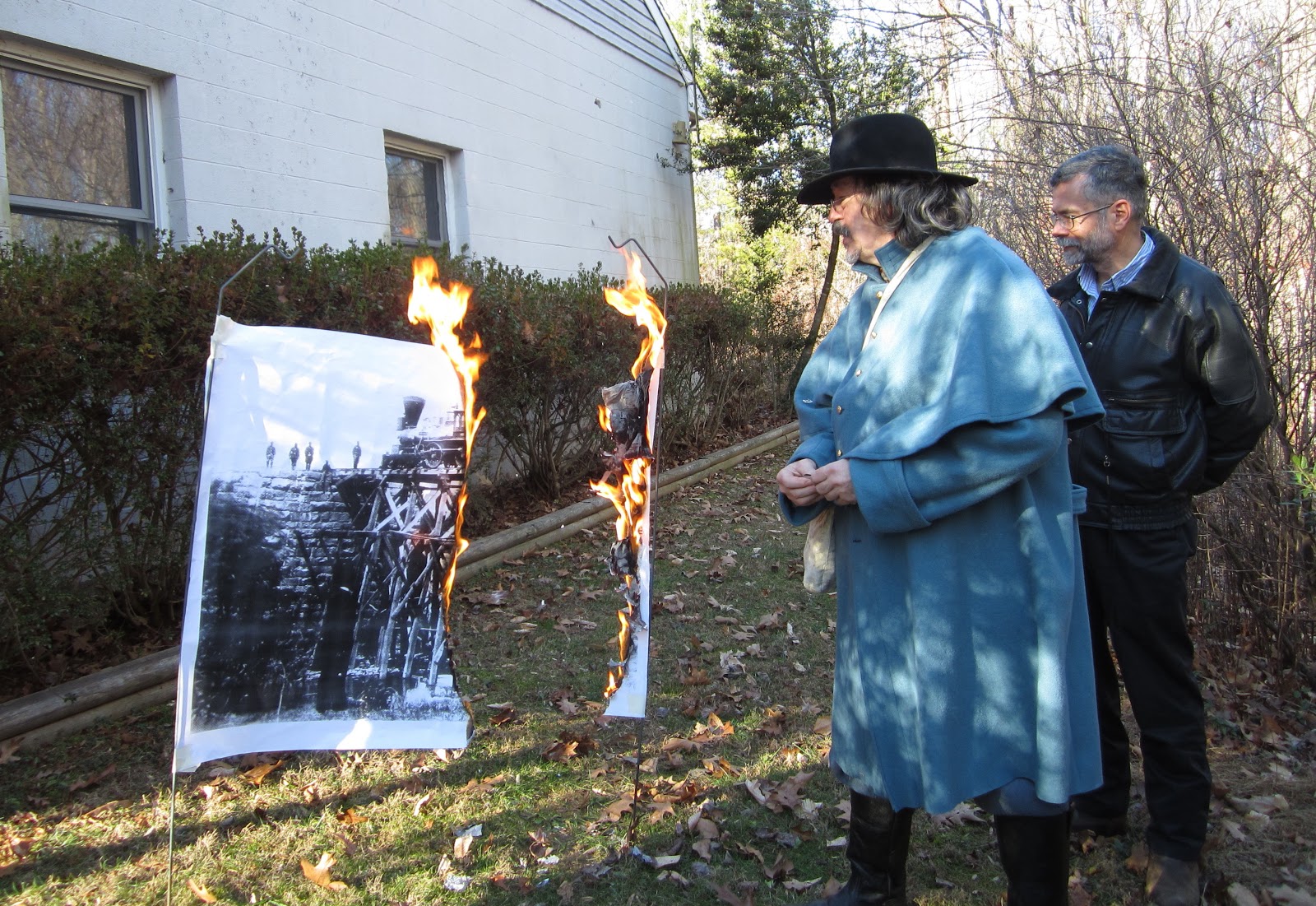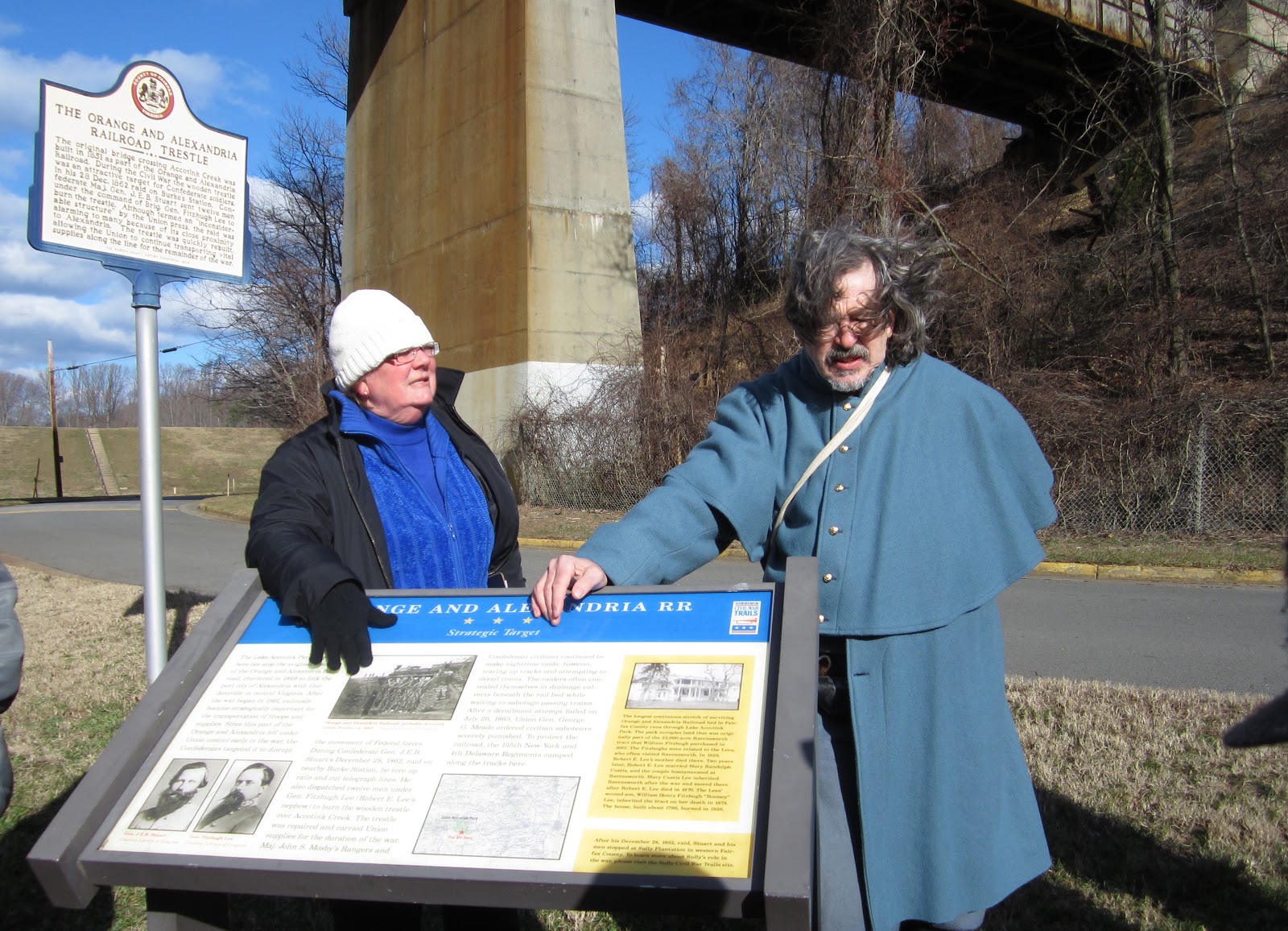150th anniversary of the raid at Accotink and Burke commemorated
 |
| John Vrana, in a coat like those worm by the Confederates, sets fire to a photo of the old Accotink bridge. |
A bunch of history enthusiasts gathered at Lake Accotink Park Dec. 30 to commemorate the 150th anniversary of the Confederate raids on the Orange and Alexandria Railroad trestle bridge and the railroad station in Burke.
About a dozen Confederate cavalry troops led by Gen. Fitz. Lee set fire to the bridge on Dec. 28, 1862, so the commemoration included the burning of a picture of that bridge by John Vrana, president of the Burke Historical Society, who was wearing a Confederate uniform. The old wooden bridge, located close to the current railroad bridge, suffered slight damage and was quickly repaired by Union forces.
There were no major Civil War battles in Fairfax County, but there were lots of skirmishes, said Mary Lipsey, who represents the Braddock District on the Fairfax County History Commission and heads an initiative to document and preserve old cemeteries. The county was a crossroads and was controlled by both sides at various times during the war.
 |
| Mary Lipsey and John Vrana by the historic markers near the modern-day bridge at Lake Accotink. |
Vrana provided some historical context: On May 23, 1861, Virginia voted to secede, and federal forces took over Alexandria and the office of the Orange and Alexandria Railroad the following day. The Southern forces were able to get most of the rolling stock out of harm’s way before that happened.
“Railroads were a new technology in this war,” Vrana said, and whoever controlled them had a strategic advantage. The first time railroads were used for moving troops and supplies was at the Battle of Manassas.
The raids at Accotink and Burke were carried out by troops in the Army of the Potomac under the command of Gen. JEB Stuart. In the evening of Dec. 28, the troops overtook the Burke railroad station, which wasn’t defended, and captured about 100 to 200 soldiers and about 15 to 20 supply wagons.
 |
| The old trestle bridge at Accotink. |
Vrana and Lipsey quoted from old news articles and letters to fill in some of the personal stories that happened during those raids.
For example, the Confederates captured a civilian at Burke named William Holsapple, Lipsey said. He was a recent immigrant from New York and a Union sympathizer who served as the community’s doctor. When Holsapple was brought before Stuart and Fitz Lee, some Confederates who knew him said he was a “quiet and peaceful man.” But before they let him go, they ordered him to stand on the railroad tracks and not move until the soldiers were out of sight.
When Holsapple returned home, he found a Union soldier there. He hid the man in a bed and hid his uniform. Holsapple later became a member of the Home Guard in Alexandria. After the war, he filed a claim seeking over $1,300 in compensation for livestock, crops, and wood taken from his farm by the Union army. The government denied the claim because he had voted for secession, supplied hay to the Confederates, and overstated his damages. Holsapple had a small grist mill on Pohick Creek and its ruins are still there.
 |
| Vrana locates the sites of the raids on a copy of an 1862 map. |
One of the men in the group ordered to burn the bridge at Accotink was John Fontaine, who had been appointed assistant surgeon of the Volunteer Forces of Virginia in 1861 when he was 21 years old. He also served as dentist and veterinarian to the Confederates. In May 1864, he was one of the doctors who attended to Gen. Stuart who had been mortally wounded at the Battle of Yellow Tavern. Fontaine was killed four months later during the siege of Petersburg.
The role of the telegraph operator was crucial in the Civil War, said Vrana. For example, when J.A. Flagg, the Union telegrapher at Burke Station, learned the Confederates were gathering a few miles away, he sent wires to the War Department and to the conductors of two trains in the area. As a result, those trains were able to cross the Accotink and reach Alexandria in safety before the raid on the bridge.
Vrana performed music from that era, including the song, “Riding the Raid,” which is about the capture of the Orange and Alexandria Railroad at Burke Station.
 |
| An Amtrak train heading to Washingt0n. |


Anyone know where we can hear this song? Cool, thanks for posting.
The critical Battle of Chantilly was fought in Fairfax County.
https://www.youtube.com/watch?v=Rci-dF1bszo